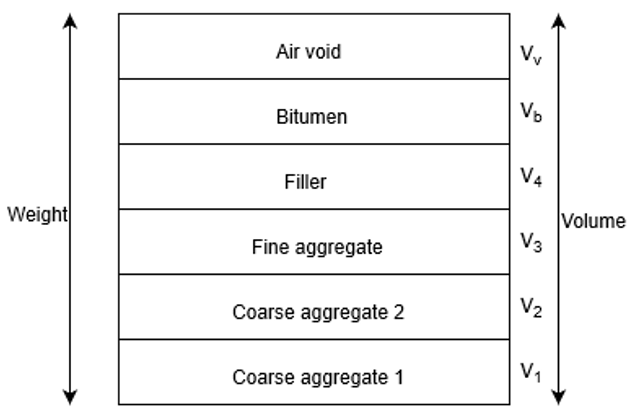This set of Pavement Design Multiple Choice Questions & Answers (MCQs) focuses on “Highway Materials – Bituminous Paving Mixes – 1”.
1. Marshall mix design method was developed by ______ in the year ______
a) George Marshall, 1959
b) George Marshall, 1939
c) Bruce Marshall, 1959
d) Bruce Marshall, 1939
View Answer
Explanation: Marshall mix design method was developed by Bruce Marshall in the year 1939. He used to work in the Mississippi highway Department and his method was refined by the US army. George Marshall was an American soldier and he passed away in 1959.
2. ______ is a property that measures the level bending stress.
a) Durability
b) Flexibility
c) Workability
d) Stability
View Answer
Explanation: Flexibility is used to check the level bending stress of the bituminous mix. Durability is resistance against weathering, workability of mix decides the ease of using it and stability is the factor that checks the resistance of mix to deformation.
3. What is the speciality of an open-graded bituminous mix?
a) Binder is missing
b) Binder and filler are missing
c) Fine aggregate is missing
d) Coarse aggregate is missing
View Answer
Explanation: Open-graded mix is the one in which fine aggregate and filler are missing. In a gap-graded mix, some coarse aggregates are missing. Binder is absent in case of an unbounded mix.
4. There must be sufficient air voids in compacted bitumen.
a) True
b) False
View Answer
Explanation: It is important that a sufficient amount of air voids is present in the compacted bitumen. This is to ensure that there is still some space for the additional settlement that can happen due to the movement of traffic over it.
5. Longitudinal ridging due to the channelization of traffic is called as _____
a) Grooving
b) Shoving
c) Ridging
d) Skidding
View Answer
Explanation: There are two types of failures to be considered for designing bituminous mixes. Grooving represents the longitudinal ridging due to channelization of traffic and shoving represents transverse rigid deformation which occurs in areas that are subjected to severe acceleration.
6. ______ method consists of three basic steps for designing a bituminous mix.
a) Hveem
b) Superpave
c) Marshall
d) Hubbard-Field
View Answer
Explanation: Hveem method consists of three steps namely, aggregate selection, binder selection and optimum binder content determination. There are six steps in the Marshall mix design process.
7. Which of the below is not an example of filler used in mix design?
a) Rock dust
b) Bitumen
c) Cement
d) Lime
View Answer
Explanation: Bitumen is an example of the binder used in the mix. Filler materials are used to fill the voids and stiffen the binder. Examples of filler are rock dust, cement and lime.
8. The phase diagram of a bitumen mix is given below. What terms are used to represent VMA?

a) V1 + V4
b) Vv – Vb
c) Vv + Vb
d) V1 – V4
View Answer
Explanation: Phase diagram of a bitumen mix has been used to simplify the calculation of various parameters like gravity, amount of void filled bitumen, percentage of air voids, etc. VMA stands for voids in mineral aggregate and it is expressed as Vv + Vb. it is the volume of voids in aggregates, which are filled with air and bitumen.
9. Which are the two major parameters considered in the Marshall mix design?
a) Workability and stability
b) Density and stability
c) Density and durability
d) Durability and stability
View Answer
Explanation: Density and stability are the two important features that are used in the Marshall mix design procedure. Density is checked using void analysis and stability using the flow test.
10. Using Hveem mix design method, the optimum bitumen content is found out using which test?
a) Stabilometer test
b) Flow test
c) Centrifuge kerosene equivalent test
d) Cohesiometer test
View Answer
Explanation: The optimum bitumen content (OBC) can be found out using the CKE test i.e. the centrifuge kerosene equivalent test. The test gives the percentage of kerosene absorbed and then the OBC can be found using design charts.
11. The flow value as per Marshall method is found out to be 18% and is found to be satisfactory.
a) True
b) False
View Answer
Explanation: The specified value for flow value at 0.25 mm units is between 8 to 16. The value obtained as per the question is 18, which is beyond the limits, so the result is not satisfactory.
Sanfoundry Global Education & Learning Series – Pavement Design.
To practice all areas of Pavement Design, here is complete set of 1000+ Multiple Choice Questions and Answers.
If you find a mistake in question / option / answer, kindly take a screenshot and email to [email protected]
- Practice Civil Engineering MCQs
- Check Civil Engineering Books
- Apply for Civil Engineering Internship
- Check Pavement Analysis and Design Books
